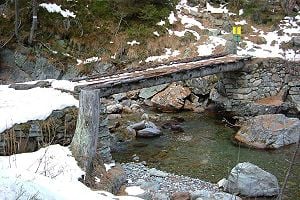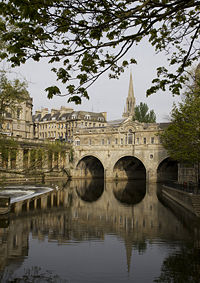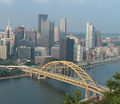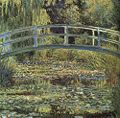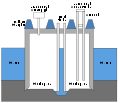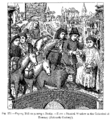Bridge
- This article is about the edifice (including an index to articles on specific bridge types). For other uses of the term, see Bridge (disambiguation).
A bridge is a structure built to span a gorge, valley, road, railroad track, river, body of water, or any other physical obstacle. Designs of bridges vary depending on the function of the bridge and the nature of the terrain where the bridge is to be constructed.
History
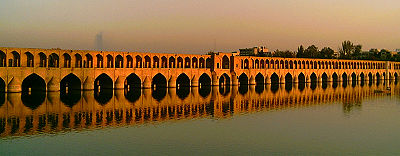
The first bridges were spans made of wooden logs or planks and eventually stones, using a simple support and crossbeam arrangement. Most of these early bridges were very poorly built and could rarely support heavy weights. It was this inadequacy which led to the development of better bridges. The arch was first used by the Roman Empire for bridges and aqueducts, some of which still stand today. These arch based bridges could stand in conditions that would previously have swept any bridge away.
An example is the Alcántara Bridge, built over the river Tagus, near Portugal. Most earlier bridges would have been swept away by the strong current. The Romans also used cement, which reduced the variation of strength found in natural stone. One type of cement, called pozzolana, consisted of water, lime, sand, and volcanic rock. Brick and mortar bridges were built after the Roman era, as the technology for cement was lost then later rediscovered.
Although large Chinese bridges existed in wooden construction since the ancient Warring States, the oldest surviving stone bridge in China is the Zhaozhou Bridge, built from 595 to 605 C.E. during the Sui Dynasty. This bridge is also historically significant as it is the world's oldest open-spandrel stone segmental arch bridge. European segmental arch bridges date back to at least the Alconétar Bridge (approximately 2nd century AD), while the enormous Roman era Trajan's Bridge (105 C.E.) featured open-spandrel segmental arches in wooden construction.
Rope bridges, a simple type of suspension bridge, were used by the Inca civilization in the Andes mountains of South America, just prior to European colonization in the 1500s.
During the 18th century there were many innovations in the design of timber bridges by Hans Ulrich, Johannes Grubenmann, and others. The first engineering book on building bridges was written by Hubert Gautier in 1716.
With the Industrial Revolution in the 19th century, truss systems of wrought iron were developed for larger bridges, but iron did not have the tensile strength to support large loads. With the advent of steel, which has a high tensile strength, much larger bridges were built, many using the ideas of Gustave Eiffel.
Etymology
The Oxford English Dictionary traces the origin of the word bridge to an Old English word brycg, of the same meaning, derived from a hypothetical Proto-Germanic root brugjō. There are cognates in other Germanic languages (for instance Brücke in German, brug in Dutch, brúgv in Faroese or bro in Danish, Norwegian and Swedish).
The word for the Pope, pontiff, comes from the Latin word pontifex meaning "bridge builder". It can also mean just "builder".
Types
There are six main types of bridges: beam bridges, cantilever bridges, arch bridges, suspension bridges, cable-stayed bridges and truss bridges.
By use
A bridge is designed for trains, pedestrian or road traffic, a pipeline or waterway for water transport or barge traffic. In some cases there may be restrictions in use. For example, it may be a bridge carrying a highway and forbidden for pedestrians and bicycles, or a pedestrian bridge, possibly also for bicycles. A Road-rail bridge carries both road and rail traffic.
The area underneath several bridges have become makeshift shelters and homes to homeless people.
The undersides of bridges all around the world are spots of prevalent graffiti.
An aqueduct is a bridge that carries water, resembling a viaduct, which is a bridge that connects points of equal height.
Decorative or ceremonial
To create a beautiful image, some bridges are built much taller than necessary. This type, often found in east-Asian style gardens, is called a Moon bridge, evoking a rising full moon.
Other garden bridges may cross only a dry bed of stream washed pebbles, intended only to convey an impression of a stream.
Often in palaces a bridge will be built over an artificial waterway as symbolic of a passage to an important place or state of mind. A set of five bridges cross a sinuous waterway in an important courtyard of the Forbidden City in Beijing, the People's Republic of China. The central bridge was reserved exclusively for the use of the Emperor, Empress, and their attendants.
Structural and evolutionary taxonomy
Bridges may be classified by how the four forces of tension, compression, bending and shear are distributed through their structure. Most bridges will employ all of the principal forces to some degree, but only a few will predominate. The separation of forces may be quite clear. In a suspension or cable-stayed span, the elements in tension are distinct in shape and placement. In other cases the forces may be distributed among a large number of members, as in a truss, or not clearly discernible to a casual observer as in a box beam. Bridges can also be classified by their lineage, which is shown as the vertical axis on the diagram to the right.
Efficiency
A bridge's structural efficiency may be considered to be the ratio of load carried to bridge weight, given a specific set of material types. In one common challenge students are divided into groups and given a quantity of wood sticks, a distance to span, and glue, and then asked to construct a bridge that will be tested to destruction by the progressive addition of load at the center of the span. The bridge taking the greatest load is by this test the most structurally efficient. A more refined measure for this exercise is to weigh the completed bridge rather than measure against a fixed quantity of materials provided and determine the multiple of this weight that the bridge can carry, a test that emphasizes economy of materials and efficient glue joints (see balsa wood bridge).
A bridge's economic efficiency will be site and traffic dependent, the ratio of savings by having a bridge (instead of, for example, a ferry, or a longer road route) compared to its cost. The lifetime cost is composed of materials, labor, machinery, engineering, cost of money, insurance, maintenance, refurbishment, and ultimately, demolition and associated disposal, recycling, and replacement, less the value of scrap and reuse of components. Bridges employing only compression are relatively inefficient structurally, but may be highly cost efficient where suitable materials are available near the site and the cost of labor is low. For medium spans, trusses or box beams are usually most economical, while in some cases, the appearance of the bridge may be more important than its cost efficiency. The longest spans usually require suspension bridges.
Special installations
Some bridges carry special installations such as the tower of Nový Most bridge in Bratislava which carries a restaurant. On other suspension bridge towers transmission antennas are installed.
A bridge can carry overhead power lines as the Storstrøm Bridge.
Visual index
Index to types
- Concrete box girder bridge.JPG
Box girder bridge - ThreeTwrBrCenter.jpg
Cable-stayed bridge - BNSFBridgeClip.jpg
Lift bridge - PlateGirderUnderTracks.jpg
Plate girder bridge - ArmyPontoonBr.jpg
Pontoon bridge - WinnepegBridge.jpg
Side-spar cable-stayed bridge - CapilanoBridge.jpg
Simple suspension bridge - StepStoneBridge.jpg
Step-stone bridge - BridgeSubmerging4.jpg
Submersible bridge - BoxerwoodDotComZigZag.jpg
Zig-zag bridge
- Titanbridger.jpg
Armoured vehicle-launched bridge - Guilford vermont covered bridge 20040820.jpg
Covered bridge - IRBSideViewClip.jpg
Inca rope bridge - JetwayAtVancouverBC.jpg
Jetway - SFOakBBLaticeBeamsClose.jpg
Lattice girder
(laced strut or tie) - Guilford vermont bridge covered bridge interior 20040820.jpg
Lattice truss
(Town's lattice truss) - SFTGMoonBridge.jpg
Moon bridge - WeighBridge5500.JPG
Weigh bridge
See also
- Landscape architecture
- Architectural structure
- BASE jumping
- List of bridges
Template:Bridge footer
External links
- Interactive Google Based Map of US Bridges - USbridgemap.com
- Structurae - International Database and Gallery of Structures with over 10 000 Bridges.
- American Society of Landscape Architects Designing Bridges in Landscape Architecture - The Bridge Architect
- American Society of Civil Engineers History and Heritage of Civil Engineering - Bridges
- Bridge Building — Art and Science Comprehensive explanations about bridges.
- Bridge Basics A guide to bridge terminology and styles
- Bridge disasters
- A dictionary of bridge terms
- Digital Bridge Library at Lehigh University
- Bridges and Tunnels of Allegheny County and Pittsburgh, PA Details of over 2,000 bridges of 8 feet span or greater. Bridge engineers hold their conventions in Pittsburgh.
- Federal Highway Administration Bridge Technology
- Video on how bridges are made (Grade school level educational film by National Association of Manufactures.) Caution: Other links on this page may lead to politically biased material.
- Federal Highway Administration - The Landscape Architect's Role as Designer of Roads and Bridges
- Photos and history about more than 300 bridges
- Atlanta, Georgia's Worst Bridges
ar:جسر az:Körpü zh-min-nan:Kiô (kau-thong) bs:Most br:Pont bg:Мост ca:Pont ceb:Tulay cs:Most cy:Pont da:Bro (konstruktion) de:Brücke et:Sild el:Γέφυρα es:Puente eo:Ponto fa:پل fr:Pont gd:Drochaid gl:Ponte ko:다리 hi:सेतु hr:Most id:Jembatan iu:ᑭᒍᑎᙳᐊᑦ ᓂᐱᑎᓯᒪᔪᑦ/kigutinnguat nipitisimajut os:Хид (арæзтад) is:Brú it:Ponte he:גשר lad:Ponte lo:ຂົວ lb:Bréck (Architektur) lt:Tiltas jbo:cripu hu:Híd ms:Jambatan nl:Brug (bouwwerk) nds-nl:Brogge (bouwwark) ja:橋 ka:ხიდი no:Bro nn:Bru nds:Brüch pl:Most pt:Ponte ro:Pod qu:Chaka ru:Мост sq:Ura simple:Bridge sk:Most sl:Most sr:Мост sh:Most fi:Silta sv:Bro ta:பாலம் th:สะพาน vi:Cầu tr:Köprü (yapı) uk:Міст (споруда) zh-yue:橋 zh:橋
